Subscribe to my blog
Make your life easier - my blog posts delivered directly to your inbox.
Hawker-Overend Fishing
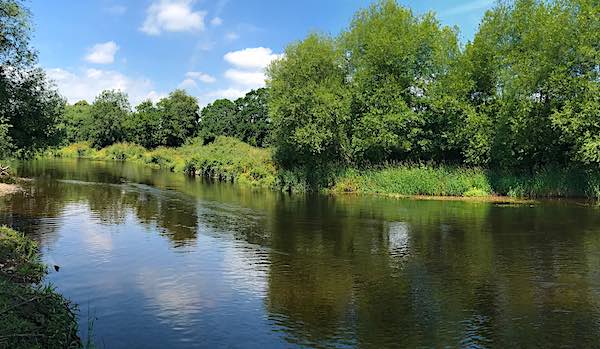
I’ve produced this Welsh Dee fly fishing guide to share with you my knowledge on how to fish Cadbury’s Pool. This pool is part of Bangor On Dee Salomon Angling club Village beat.
The Cadbury’s Pool holds some good grayling and trout, which I prefer to fish when the Welsh Dee is close to its summer level (ca. less than 0.6m Manley Hall gauge).
During the height of summer, it’s a great place to fish because the large overhanging trees on the right bank cast shade on to the river as it flows eastwards.
I have seen a few salmon jump as they run into the tail of Cadbury’s Pool but I’ve not managed to hook one fly fishing there. However, local anglers report that the tail of the pool is an excellent spot for salmon and sea trout, with fish holding on the left bank.
Cadbury’s Pool a great place for fly fishing on the Village beat at Bangor On Dee. Especially, when the river is close to its summer level (ca. 0.5m Manley Hall) because it’s easy to access and holds a good population of grayling and trout.

I have produced this sketch of Cadbury’s Pool to show you where to catch trout and grayling when the Welsh Dee is at its summer level (ca. 0.5m @ Manley Hall).
My approach to fishing this pool is dependent on the following variables:
If you see any signs of surface fly-life activity, even if you haven’t seen any rising fish, I find it best to first fish the pool with a dry fly…
This is often referred to prospecting for trout and grayling i.e. covering the areas of water where you expect a fish to be lying.
For newcomers, the best approach to fish Cadbury’s Pool is with a single dry fly, attached to a 9ft 5X tapered leader tipped with 3ft of 3lb copolymer.
Select a dry fly that matches the hatch, in at least size and overall colour.
Usually, when the river is at its summer level, I find it best to start fishing the pool with the dry fly from point A and fish upriver to point D.
On the photograph, I have outlined in red the area that you should prospect with the dry fly up to point B.
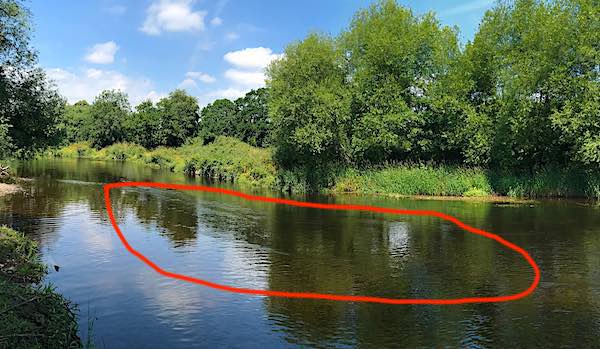
In the summer, a weed-bed grows close to the near bank between points A and B. Grayling and trout lie in the slack water behind the weed-bed and on the far-edge of the weed in the seam between the slack and fast water…
If you not occasionally hooking the weed-bed, then you are not fishing close enough to it.
The area fish are normally found is in the slack water close to the far bank but with the main flow through the centre of the river it takes some skill to make a drag-free dry fly presentation into that zone.
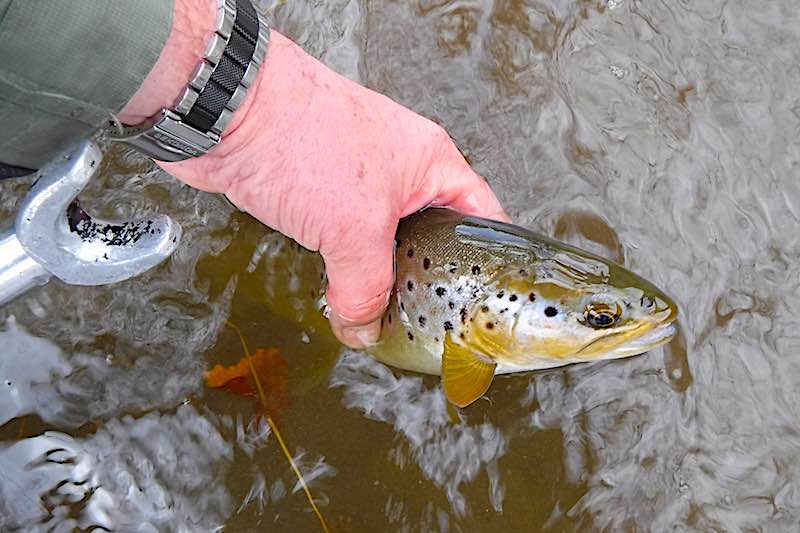
In the fast run at the head of the pool (C to D), target the slacker water close to the far bank because this is where the trout are tucked into.
If the dry fly doesn’t produce any takes then it is worth returning to point A and fish up through the pool again with a “Klink & Dink” set-up. Basically, a small nymph suspended 3-4ft under a buoyant dry fly acting as an indicator.
It’s best to base your fly choice on imitating the flies that are hatching. However, if this is no possible one of the following will usually catch trout and grayling:
For more information on dry fly fishing and additional flies check out the following post:
What to do when you’ve fished through the pool with the dry fly or the Klink & Dink method but don’t get any takes?
When this happens to me I switch to searching the riverbed with a team of nymphs on a short line (i.e. Euro or Czech nymphing). Often this approach is required on cold days but also works on bright sunny days when the river is running crystal clear and the fish are sheltering on the bottom.
In the summer focus searching the deep water around the weed bed located between points A and B, because this is where I’ve had the most success.
During the colder months search all the pool from point A to D since grayling and trout are probably grubbing on the river bed for food. Its important fish your nymphs close to the riverbed and if they are not occasionally clipping the bottom you are not fishing deep enough.
Nymph selection for the Welsh Dee depends on a number of conditions that are covered in detail in the fly fishing technique page. Below is a typical example of a team of nymphs I will use when the river is running clear.
The heavy nymph is used to drag the small nymphs to the river bed quickly.
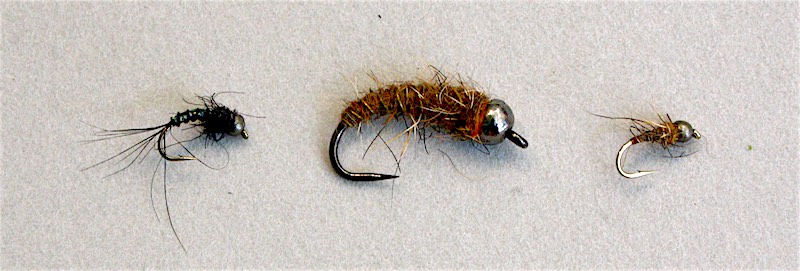
Often, I fish the heavy nymph on the point but if grayling are predominately taking the middle dropper I will move the heavy nymph up to the middle dropper. This ensures that both small nymphs are fishing close to the riverbed, which can increase the catch rate. However, it can lead to more snag-ups.
In coloured water, I will tend to use larger nymphs that have a bright spot (e.g. colourful tungsten bead, bright tags, etc). Below is a typical example of a team of nymphs I will use when the river is coloured.
Additional examples can be found in the fly fishing technique page devoted to Czech nymphing.

Often, I switch to fishing the pool with wet flies when nymphing doesn’t catch anything, or when the catch rate fades because fish have started to take flies higher in the water column. The latter usually happens…
“around mid-day due to a surface temperature rise”.
When it’s not possible to identify what flies grayling are feeding on, I will start with one of my workhorse team of wet flies /spiders spaced 3ft apart on 3lb copolymer leader, depending on the time of year.
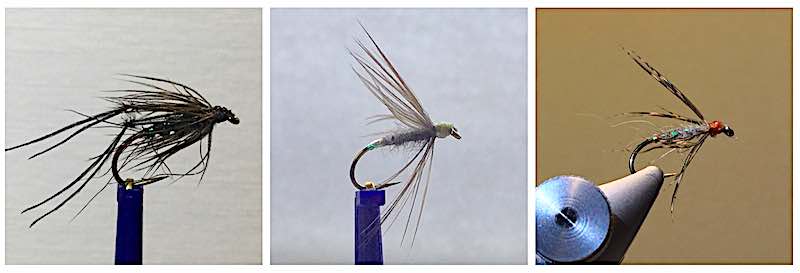
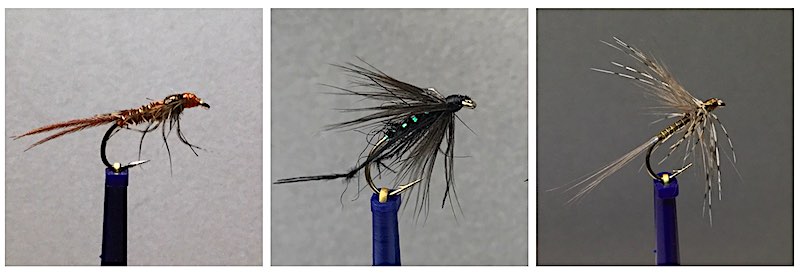
If after 15 – 20 minutes, I haven’t had any takes, I start trying other patterns until success comes. That said, the workhorse teams rarely fail to catch grayling.
I find it best to start fishing the wet-flies / spiders in the tail of the pool (point A) and methodically working upriver. Casting the flies upriver at a 45-degree angle and allowing them to dead-drift downriver. When the flies drift downstream of me, I mend the line to slow the swing to the dangle.
Even if trout and grayling are rising close to the far bank, it is often wise to resist the temptation to cast directly to them.
A better approach is to divide the river into 3ft lanes and search each lane before the lane holding the rising fish. This often yields extra grayling that you have not seen and would have been spooked by casting over them.
If there is a strong downstream wind, I find it best to start at the head of the pool (point D) and fish the wet flies across and downstream.
I have a separate page on Wet Fly fishing that has more information on the approach I find successful on the Welsh Dee.
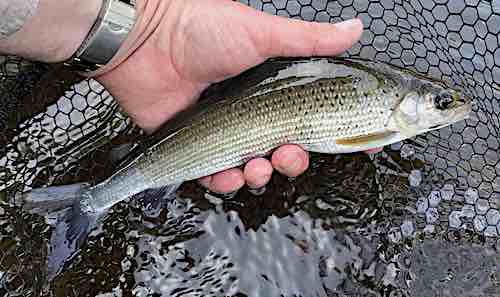
The brown trout fishing season on the Welsh Dee starts on the 3rd March. Unfortunately, the river level is often too high to go fly fishing on the Cadbury’smPool, and thus I don’t fish this pool until May.
If the river level was at or below 0.6m (Manley Hall gauge) then it would be worth a try.
On mild days, hatches of large dark olives and March Browns usually start around 11 am and you will often spot trout picking them off as they drift through this pool. During these hatches, my approach is to target the rising fish with the dry fly (large dark olive or March Brown pattern).
For more information on the fly selection for fishing during March check out the following article:
Once April arrives on the Welsh Dee, the weather usually starts to warm up and hatches of Large Dark Olives, March Brown, Grammon and other olives become more prevalent from mid-morning to mid-afternoon. Providing opportunities to catch trout on the dry fly, by matching the hatch.
For more information on the fly selection for fishing during April is covered in the following post.
As the weather warms and dries up during May, fly hatches become prolific and brown trout become eager to fatten up on the emerging fly life. Examples of flies you will see include:
Upwinged flies:
Sedges:
Others:
As a result of all the fly-life, May is when dry-fly and upstream wet-fly fishing produce the best catch results, when you have identified which flies the trout are taking.
Even on sunny days, the trout fishing can be good from morning to dusk, but the best fishing is often in the morning and evening.
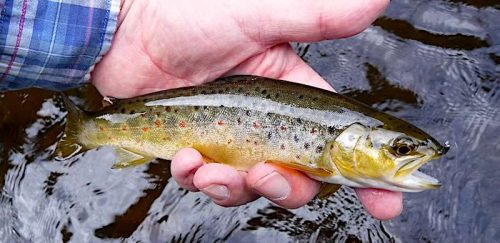
For more information on the fly selection for fishing during May is covered in the following post.
When the river is low during the summer months, the oxygenated water flowing through the Cadbury’s Pool is a good place to fish. On sunny days, this section of the river can continue to yield grayling and trout all day.
More information on the fly selection for summer is covered in the following posts.
My attention turns to grayling fly fishing from October to the end of February on the Welsh Dee.
During autumn and winter, river conditions often dominate my grayling fishing activities and I will only fish this pool if the river is running clear and the level is below 0.6m (Manley Hall gauge).
During October on the Welsh Dee, fly hatches are still common on most days. The flies you are likely to see hatching include:
October mornings tend to be cool and fly hatches don’t usually start until mid-morning and usually wait until then to fish Cadbury’s Pool, with the dry fly or Klink & Dink.
Ideally, it’s best to try and identify the flies that are being taken and tie on a suitable imitation.
If that is not possible, I usually start with a CDC olive emerger pattern that has served me well, and if that doesn’t work I start working through my fly box. However, it’s rare not to catch a grayling on one of the three following patterns:

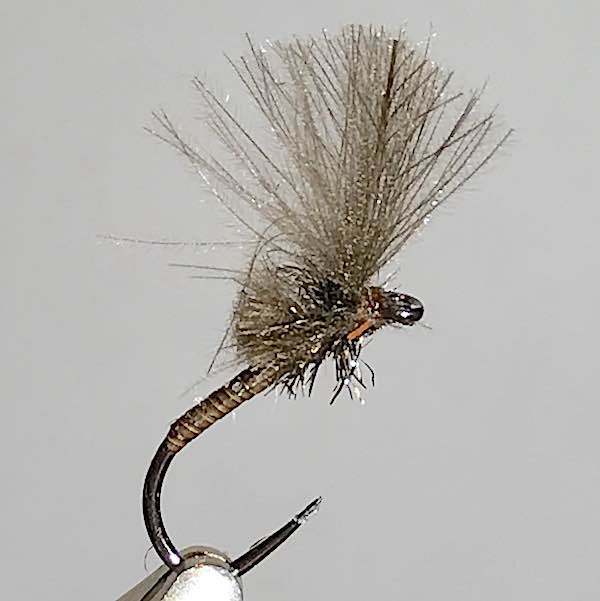

On rare occasions, it’s not possible to tempt grayling with either of the above approaches, it necessary to switch to fishing nymphs close to the riverbed.
Check out the link below for additional reading on flies for October:
The clocks go back at the end of October and the days become increasingly shorter during November. At this time of year, the river is often too high to fish Cadbury’s Pool with the fly.
Therefore, with limited day-light hours, I often fish more productive pools where grayling have started to shoal.
During June / July the pools near Bangor On Dee become to be populated with sea trout and a few rest up in the Cadbury’s Pool during their journey upriver.
I rarely fish the Cadbury’s Pool for sea trout after dark because the bank is too hazardous. However, I do fish the pool for sea tout during the last couple of daylight using small wet flies for the last hour of daylight.
When you get a take, once you have set the hook, you just have to let the fish take off until you know what’s on the end of the line, since it’s just as likely to be a big grayling or brown trout than a sea trout.
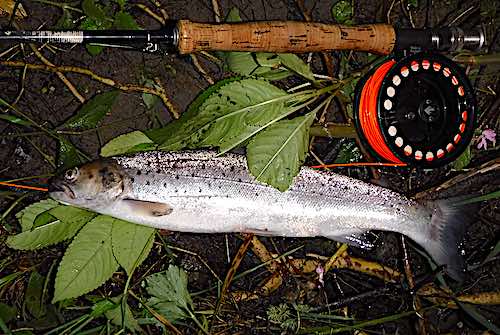
When you get a take, once you have set the hook, you just have to let the fish take off until you know what’s on the end of the line, since it’s just as likely to be a big grayling or brown trout than a sea trout.
The sea trout I’ve caught fishing the Cadbury’s Pool have not been large (i.e. 1 to 2lbs bracket) but they still are great sport.
To date, I have not managed to catch any salmon from Cadbury’s pool. Therefore, the following advice is based on talking to anglers who have had more success than me and where I have seen fish show over the years.
In low water conditions, salmon hold in the deeper water on the bend, which is sheltered by the overhanging trees on the far bank. Therefore, it’s important to cast the fly as close to the far bank as possible and let it swing round to the dangle. Don’t be in a hurry to recast because salmon can slow in taking the fly on the dangle.
In high water, fish tend to lie closer to the near bank and the deeper water close to the end of the pool. Under these conditions, it is always best to fish the pool from the bank because they can be tucked quite close to the bank. Then if it’s safe to wade, fish through the pool again because this will change the position at which the fly will come round to the dangle.
This is a very good question and is one I have struggled with for many years of fishing the Welsh Dee. There is likely to be an answer but you need to be catching 30+ salmon per year to end up with a statistically significant answer.
Therefore, I use the following simple strategy:
For fly selection, I normally follow this simple approach:
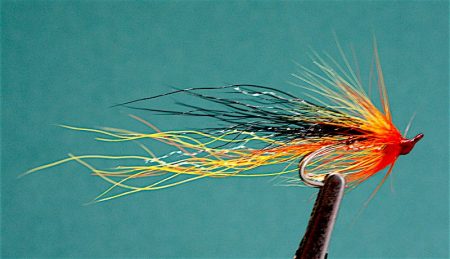

My reason for a simple fly selection strategy is that on the Welsh Dee the more important question is…
Once you’ve identified a potential lie, your attention should be focused on how best to cover the fish such that it will take your offering.
I’ve found salmon are either interested in taking mode or not…
Most of the salmon I have caught have been on the first run through the pool. Therefore, fish the pool quickly and then move on to the next one.
The aim is to cover as much of the river as possible in search of a taker. A side benefit of this strategy is you’ll get plenty of exercise, which keeps you fit!!!
Finally, I do hope you have found this Welsh Dee fishing guide for Cadbury’s Pool interesting and informative.
Cadbury’s Pool is located about half-way down Village beat at Bangor On Dee. It is reached by taking the footpath near the entrance to the Royal Oak Pub car park and walking downriver for about 1000m.
[N.B. before fishing check that access has not changed on the Bangor On Dee Salmon Anglers website].
[Disclaimer – like most outdoor sports, fishing is not without its hazards. Therefore, you MUST do your own RISK ASSESSMENT before starting to fish; especially if you decide to wade and/or fish at night. In addition, you must follow the Bangor On Dee Salmon Anglers club rules when fishing this water.]
Subscribe to my blog
Make your life easier - my blog posts delivered directly to your inbox.